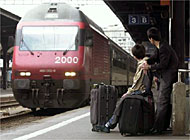
Swiss trains: a blind man’s odyssey

Imagine standing in the middle of a large train station teeming with commuters, with your eyes shut and a stick in your hand: could you find your way to the train?
You couldn’t read the departures board, or the signs pointing to platforms. You couldn’t see whether you’re walking in the right direction, or into a wall. If you make it to the platform, you wouldn’t be able to see whether your train has arrived, or where the doors are.
Thousands of blind people face this Herculean challenge every day. For them, the simple business of walking around a station and changing trains is an exercise demanding utter concentration, patience and, above all, determination.
To get a sense of what blind people go through when travelling alone, I spent a day accompanying Urs Kaiser, who is completely blind and uses a stick to navigate.
We met in the main hall of the railway station in Bern, almost an hour ahead of the journey, to leave Urs with enough time to find the train.
An obstacle course
As I began to follow him, while he tapped his guide stick, I had a sense that even a short walk inside a station is for him an obstacle course riddled with people, stands, bins and walls, all conspiring to stand in his way.
The first thing Urs pointed out was that he was lost without tactile guidelines, which are raised lines on the ground signalling a path or the edge of the platform. “I get lost if there are no guidelines, because when I’m in a big open place, there’s nothing like a wall or an orientation mark for me to follow,” he said, as he slowly tapped along.
The absence of guidelines in Bern’s station soon became apparent when Urs encountered a newly erected display of glass and metal panels, which were enough to throw him off course. As he guided his stick along the panels, he lost his bearings and headed off in the wrong direction.
“But I can hear the escalators!” he exclaimed. “Oh, I’m completely in the wrong place.” He turned about slowly, listened out for familiar noises and finally asked me where we were.
There was no talking as Urs concentrated on finding his way back to the area leading to the platforms, trying to stay close to a wall even if people and containers were in the way. He then groped his way to the nearest handrails leading up the concourse.
Finding an etching
“Now I’ve found the handrail, I need to find the brail etching with the platform number to see if it’s the right one,” he said. “So, reading this, I can tell I need to walk to the opposite side to find my train.”
As Urs cautiously edged up the stairs and arrived at the platform, I thought the worst part of the journey was over. But there was still the matter of actually finding the train.
“I have to ask myself if there’s a train on the tracks or not. Often, I can’t hear the noise of my train on the platform because it’s drowned out by other trains,” he said.
As Urs held out his stick to feel for the train, I imagined how often he must come perilously close to the edge of the platform. “You see, this is when I really need a security line to guide me,” he said. “
Verbal announcements needed
And it would be a big help to have more announcements to tell me when the train is arriving or departing.”
Even finding the train door was a problem. “I can usually use my stick to find the entrance, but newer trains have these small knobs which I can never find,” he said. “I’m always in a hurry to find the knob to open the door before the train leaves again.”
Once aboard the train, blind travellers may hear no audio announcements calling out the next station stop, and they find brail lettering scarce.
As we came to the end of our journey, Urs explained that trains and stations are gradually being improved to meet the needs of blind and disabled travellers.
But in the meantime, he and thousands of other blind people in Switzerland need to rely on the help of fellow travellers and their own resourcefulness to overcome the barriers they can’t see.
By Vanessa Mock

In compliance with the JTI standards
More: SWI swissinfo.ch certified by the Journalism Trust Initiative



































You can find an overview of ongoing debates with our journalists here . Please join us!
If you want to start a conversation about a topic raised in this article or want to report factual errors, email us at english@swissinfo.ch.